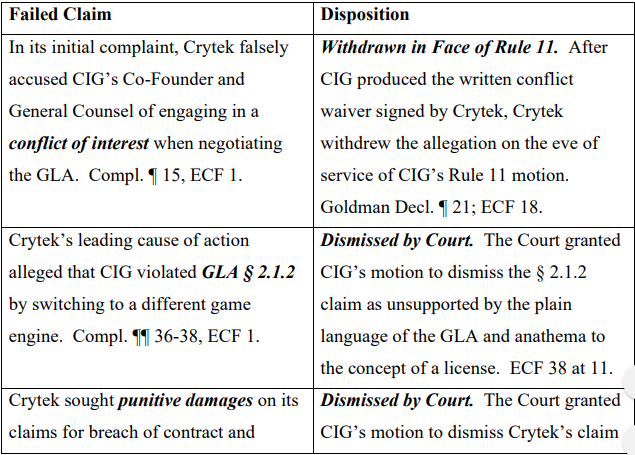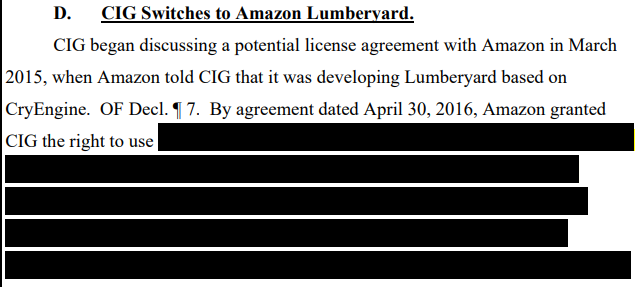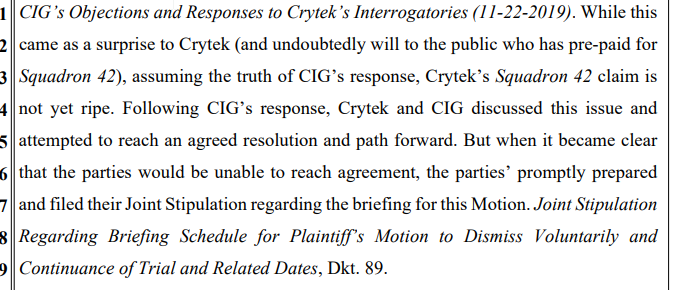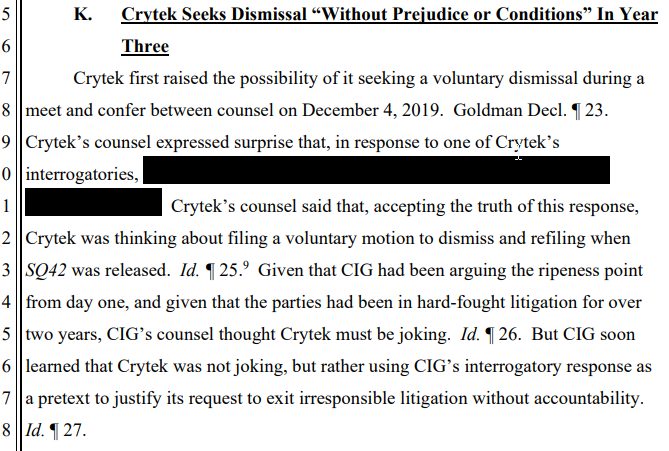I know, the bag said dead pigeon, what did I expect.
Well, you certainly established your credibility and the unquestionable validity of your inside sources. Carry on then.
I know, the bag said dead pigeon, what did I expect.
Well, you certainly established your credibility and the unquestionable validity of your inside sources. Carry on then.
God I love it when a thread gets inscrutability turned up to 11.

Well at this stage I am not inclined to believe there was any settlement of significant financial value between the parties.
Crytek moved to dismiss in Jan without prejudice stating CIG were cagey in discovery about confirming whether SQ42 would even be released as a standalone title, and so reserving right to re-file once their claim was ripe (presumably on SQ42 release).
CIG’s response was to oppose Crytek’s move to dismiss and in doing so remind Crytek and advise the court, among other things, that discovery had turned up that Crytek’s agreement with Amazon re:Lumberyard included entitlement to older versions of Cryengine, which in turn Amazon had entitled CIG to in their Lumberyard agreement.
Notice of settlement was submitted in in Feb. Notice of joint stipulation to dismiss with prejudice was submitted in March.
Looks like the lawyers were the only winners to me.
The system working as intended!
That wasn’t the gist of their filing.
That’s not accurate either.
The point(s) of the Crytek queries were (1) Lumberyard license gave Amazon the right to sub-license base CryEngine (2) when did CIG obtain it?
None of that was new.
The main contention was: when did they obtain the Lumberyard license. This is why Avni’s email to Amazon was worded in such a manner. They confirmed that CIG only got the license in 2016. But CIG were already using CryEngine for two games - since inception in 2012. In fact, that was the key part of the lawsuit (try reading it) which SURVIVED the CIG MtD.
It turns out that aside from the fact that they claimed to have switched in 2016, which was confirmed by Amazon as a license and not a code switch, they actually didn’t switch - at all. This meant that they still had traces of base Cryengine - vastly different in the Lumberyard implementation - in their code base for both Star Citizen and SQ42. This was the most devastating revelation in this whole thing. And it’s what facilitated such a hasty settlement shortly after Crytek filed their motion to dismiss (with prejudice) and laid out previously unknown things to both CIG and the public (in the filing). In fact, the redacted parts of that filing contain other allegations which were true and so devastating that Crytek filed it that way intentionally as a hold back for their lawsuit down the road when SQ42 shipped. And I know what it all says because it appears in my own findings.
Software licensing is weird. Just because you stopped using an unlicensed copy of Windows in Jan, doesn’t shield you from breaches in the prior month of Dec just because you stopped and got a legit license.
To get a handle on how bad it would have been for it to be shown that both games not only still contained traces of base CryEngine indicating that they didn’t actually switch - which CIG finally admitted to as per the filing - go read Zenimax v Oculus.
It was this information that Avni obtained from Amazon that sealed the fate of the lawsuit - at THIS moment in time. Had Amazon resisted and not given that type of answer and confirmation, the lawsuit would most likely be prepping for trial (after this coronavirus fiasco was over).
The whole point of CIG objecting to the Crytek motion to dismiss (with prejudice) was because they knew what that meant. It basically meant that Crytek, now in a much stronger position, could just sit back and wait for SQ42 to launch as that was the infringing project. CIG knew this, and didn’t want that cloud hanging over their head. Especially not after taking $46m from an investor for the final dev of SQ42 - as they claimed in 2018.
Note that they didn’t even wait for the judge to rule on the Crytek motion because, as has happened in the past, could have taken months and possibly stretch right through the release (lol) of SQ42. That’s why Crytek mentioned in their filing that CIG was being cagey about the release date of SQ42.
While I do know the amount of the settlement because I know everyone involved in this on both sides - aside from the fact that I was the first to disassemble the Star Citizen binaries to prove that they hadn’t actually switched (back in 2016) and wrote a massive blog about it, which prompted Crytek to contact me about my findings - I can safely say that it wasn’t “low” at all.
Also, common sense would allow one to remember that not only did Crytek put up a large bond (which they now get back) in the lawsuit - something that most didn’t expect they could feasibly do - they were also willing to continue the lawsuit, put it on hold and wait for SQ42 etc. Why? Because it was never was about money for them. It was about the fact that Chris betrayed them, poached their people, then turned around and after raising all this money, used their software on two games - without paying them. Basically this was like you turning on your dev partners to suit yourself. CIG didn’t have the technical experts required to make the custom engine from CryEngine. And instead of continuing to pay Crytek large sums of money for that assistance, they just up and poached their people, then set up shop literally down the street from Crytek’s German offices. These guys are Turkish, so things like betrayal, traitors etc are a big frigging deal.
This is standard. Once they realized that they were in a tight spot, they started negotiating in earnest - something which hadn’t happened the past three times that CIG tried it. So by the time they agreed on what the settlement would be, all the back and forth etc, agreement being drawn up, drafted, changed, signed etc - it all takes time. So a month or so is quite normal.
Crytek and the attorneys (both sides) won because the former got what they wanted, and the latter got paid for their services. CIG didn’t gain anything because they could have just paid Crytek for a license back in 2016 and NONE of this would have been public, let alone lead to a lawsuit. Arrogance and greed led to this.
But what if their grandchildren don’t respect their wishes and forget about the lawsuit?
Well therein lies the rub :)
Crytek really screwed the fucking pooch on this entire thing when they sold the farm to Amazon, it turns out.
Most of the original claims were dismissed or withdrawn upon court requesting bond:


That left two, with the big one being the fundamental question of whether CIG had a right to use CryEngine for SQ42 if it was released as a separate title. The second being credits related to SC and SQ42. All the other noise was junked.
In Jan 2016 CIG announced SQ42 could be bought separately, potentially opening themselves up to this litigation by not having a separate CryEngine license for it.
In Dec 2016 CIG announced they were switching to Lumberyard.
Thing is, it turns out CIG’s agreement with Amazon was inked in April 2016, eight months earlier and only three months after SQ42 was ‘available separately’. In addition to that, Crytek’s agreement with Amazon entitled Amazon to earlier versions of CryEngine, including the version that underpinned SC and SQ42. Amazon in turn included access to those versions in their Lumberyard agreement with CIG.


Long story short, turns out that since April 2016, CIG don’t need a Crytek license agreement to develop and release SQ42 independantly of SC and however they see fit. Both parties are now aware of this, it is corroborated by Amazon and CIG have shared their Lumberyard license agreement with Crytek as confirmation.
That still arguably puts them in a potential breach situation with regards to the original Crytek GLA for three months - Jan to April 2016. Potential breach is a potential breach of course, but Crytek only realised this in mid 2019 due to some pretty terrible due dilligence (they obviously had access to their contractuals with Amazon, they just failed to consider the implications as it relates to CIG).
A three month potential breach becomes a long bow to hinge litigation on, particularly given the ‘years away from release’, ‘may be accessed from the SC launcher’, ‘it’s not a pre-order, it’s a donation’, ‘CIG has been in discussion with Amazon since 2015’ aspects of this. But by the by.
In Jan, as we know, Crytek filed to dismiss without prejudice. Their foundation for this was interrogatory discovery in which CIG refused to admit SQ would be released standalone, hence their primary claim was unripe.


Despite Derek’s protestations to the contrary, this is the entire gist of the motion to voluntarily dismiss.
CIG opposed the motion dismiss, ultimately as they argued it should be dismissed with prejudice, generally based on merit, but they specifically call out the Amazon license discovery and don’t shy away from accusing Crytek of using voluntary dismissal to withdraw and avoid accountability (ie potentially lose their 500k bond).


Oviously all moot now, as both parties came to terms and settled after these documents were filed.
Nobody walked away from this a winner. Crytek filed suit for what ultimately turned out to be a potential 3 month breach of contract. Both parties would have spent high 6 figures in legal fees (CIG claim 900k). At the end neither had the other over any kind of barrel and Crytek had a drastically weakened position with a 500k bond on the line. Claims of multi-million dollar settlements seem highly unreliable to me. But what do I know, IANAL, I just sleep with one.
Motions to Dismiss and Opposition to Dismiss:
Well as sharp/concise as lawyerese can be :-)
(But thanks from me too)
FALSE
Also, not relevant because the Amazon license has ZERO relevance to the CIG license or there wouldn’t have been a lawsuit to begin with. Jeez.
FALSE
There were NO new claims filed following the ruling on the MtD.

Bonus : he bond was a completely separate issue that’s standard in most lawsuits. Crytek put up the bond as per the ruling.
Not relevant. As shown - and proven via the lawsuit - they were already developing two games using CryEngine prior to the split. It still didn’t absolve them of liability or the MtD wouldn’t have been denied on this point alone.
Not relevant. Switching (which they didn’t actually do, as it turns out) a license isn’t the same as switching the code base. Especially since the underlying CryEngine code used in Lumberyard was VASTLY different than the base version. If you were a dev, you’d know the difference. Heck, thousands of software based lawsuits have been lost and/or settled on this point alone. I mean, look at Oracle.
To wit, a function in base CryEngine that doesn’t appear in Lumberyard means that snippets from both engines are in use. This is PRECISELY why CIG tripped up because they were developing TWO titles - not one. If they hadn’t split SQ42, it wouldn’t matter as any CryEngine (paid) or Lumberyard (free) license would have been covered under Star Citizen.
FALSE
And the judge agreed when she denied the MtD on these grounds alone.
Not relevant because this was NEVER in dispute. Ever.
FALSE
If you read the lawsuit filing, you’d know this. The original filing was pretty clear on this claim alone. In fact, the judge - in the MtD ruling - agreed that CIG could switch engines if they wanted to. That was never the issue after that. The issue was whether or not they had a prior license to develop SQ42 - a second title.
Except that’s not how software licensing laws work. It doesn’t matter if it’s one day or one decade. What’s relevant are the ensuing damages for said breach. And in this regard, had this gone to trial, and assuming that Crytek prevailed, the biggest weapon they would have would be damages as well as an injunction against SQ42. See Epic v Silicon Knights
You missed the part where this was always the issue because prior to the Amazon email exchange with Avni and CIG subsequently (because they would have to submit to source code discovery otherwise) admitting that they never really switched (code base), SQ42 was always going to be released stand-alone (it’s in the filings. You should read them). The issue at this moment in time was when. We’ve known since Dec 2018 that CIG had taken a $46M bailout in the Summer of 2018; and during that revelation, they announced that it was for SQ42 marketing etc. At the same time, they also released the first SQ42 roadmap with a Beta launch date of Q2/2020.
Amid all this, the trial was set for March 24, 2020. They settled Feb 20, 2020. And it was finalized by the court on Mar 23, 2020.

A defendant (CIG) with a strong case has ZERO motivation or reason to settle a case shortly before trial. Unless they knew the risks of LOSING. The same goes for the plaintiff. So with a looming trial date, CIG has no reason to settle - because they didn’t have|or need to - unless they knew something bad would ensue. Not only that, even when Crytek filed to dismiss the suit with prejudice (so they could refile after SQ42 released), CIG opposed it. Guess why that would be the case.
Next thing we know, it’s settled. Shocking.
Man, you are just choosing to be willfully ignorant at this stage. Crytek fucked this up. They did not properly consider the implications of their agreement with Amazon and brought a suit that, while seemingly having merit, significantly lost its sting once it came to light CIG’s Lumberyard licensing agreement gave them access to the exact same source covered under the Crytek GLA, thereby effectively nullifying it as it relates to SQ42. That this came to light only in mid 2019 is kind of bonkers, but whatevs.
If CIG didn’t switch engines immediately, or in a timely fashion, or at all, it’s moot - it’s because they simply didn’t need to - Lumberyard had them covered.
If you think Crytek’s claim goes all the way back to 2012 because CIG carried some liability for developing two games prior to 2016, you’re wrong. Crytek brought the suit once CIG announced SQ42 would be sold separately in late 2015, that’s what broke GLA. They state that. In their complaint. 22 through 25. You should read it. Until that point, SQ42 was feature of SC and defined as such in the GLA.
If CIG broke GLA in late 2015 and Lumberyard had them covered in early 2016, sure Crytek can argue they still breached. Would they have brought suit if they knew back then that Lumberyard had cut their lunch? Maybe, maybe not, there’s plenty of reasons for or against, but who cares now, it doesn’t matter.
Fact is, this suit is not the straw that breaks CIG’s back and they sure as hell didn’t line Crytek’s pockets with gold to get it settled.
Interesting stuff, thanks for posting.
But I see you are backing your points with actual documents, don’t you have any impressions based on rumors from secret inside sources that you can’t expose? I’m not sure if I can trust a simply fact based analysis.
That’s not how copyright works. Once something becomes derivative, it’s always derivative, and once in breach (i.e. being developed during those months, if nothing else), it’s always a derivative of something that was in breach.
Also, having “the same source [code]” is meaningless.
I don’t believe you are correct there, Goth. Amazon actually controls that IP now, and can (and apparently did) license it’s use to organizations.
If Amazon solely owns the rights to CryEngine (I can’t remember anymore), it can choose not to care. Like those developers who use the GPL stop caring when the source for embedded is eventually distributed and the license complied with. But it’s no secret that they could.
Not quite sure what you mean by this? Count 2 in the complaint covered copyright infringement as it related to CIG using copyrighted code in a second game (63) and displaying/sharing code on bugsmashers and with 3rd parties (64, 65, 66).
The latter three were dismissed or dropped, as per that table I posted (which to be fair is in CIG’s opposition to dismiss), but they are all referenced.
The first (63) is so intrinsically tied to Count 1’s breach of contract (lack of license for standalone SQ42) as to be inseperable and in turn is also nullified CIG’s license agreement with Amazon - to the extent, of course, that GLA breach potentially still existed between Jan and April 2016 (though I agree that if it did exist, then it always exists, up to statutes of limitations). CIG had licensed access to (and thereby granted copyright access to) the necessary version of CryEngine source under Cytek’s GLA and their agreement with Amazon. CIG obviously own copyright to their own code and any modification they made to CryEngine source, so that would not be subject to a copyright claim from Crytek.
What I mean is they had no license for the second game, which terminates the rights for the first game (unless I forgot some explicit clause in the GLA), so everything added in that period, as well as everything developed on top after, is tainted by the violation of being a derivative of something that is illegal.
That’s about as far as my knowledge goes, and about as much as I care to know, because it starts getting complicated. Well, I lie, it’s also clear CryTek fucked up on damages along with other clauses.